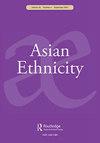从Pulau到Pulo:从菲律宾和印度尼西亚看东南亚华人的群岛视角
IF 0.8
Q3 ETHNIC STUDIES
引用次数: 0
摘要
东南亚是研究中国性问题的重要地区。然而,它是一个出了名的异质区域,从它的某些部分得出的结论在其他地方的适用性有限。这期特刊提供了基于经验的、多学科的研究,涉及并扩展了东南亚华人的现有学术研究。通过关注印度尼西亚和菲律宾,本期特刊中的文章探讨了东南亚华人的各种模式,并偏离了新加坡和马来西亚提供的熟悉范例,在新加坡和马来西亚,华人人口比例最高,拥有重要的政治权力,英语机构将华人的表述转化为学术和政治话语。在此过程中,我们呼吁认识到该地区华人社区的多样性,不仅仅是在本地化的、混合的中国性表达中,而是在混合和以多种形式持续认同中国性的共存中。本文章由计算机程序翻译,如有差异,请以英文原文为准。
From Pulau to Pulo: Archipelagic perspectives on Southeast Asian Chinese ethnicity from the Philippines and Indonesia
ABSTRACT Southeast Asia is an important region for working through questions of Chineseness. It is, however, a notoriously heterogeneous region, and conclusions derived from some parts of it can be of limited applicability elsewhere. This special issue offering empirically-grounded, multi-disciplinary research engages with and expands on existing scholarship on Southeast Asia’s Chinese. By focusing on Indonesia and the Philippines, the articles in this special issue investigate diverse models of being Chinese in Southeast Asia and depart from the familiar paradigms offered by Singapore and Malaysia, where ethnic Chinese populations are in the highest proportions and hold significant political power, and where Anglophone institutions transmute formulations of Chineseness into academic and political discourse. In so doing, we call for recognising diversity within Chinese communities in the region, not only among localised, hybrid expressions of Chineseness, but in the coexistence of both hybridity and persistent identification with Chineseness in multiple forms.
求助全文
通过发布文献求助,成功后即可免费获取论文全文。
去求助
来源期刊

Asian Ethnicity
PHYSIOLOGY-
CiteScore
2.80
自引率
6.20%
发文量
27
期刊介绍:
In the twenty-first century ethnic issues have assumed importance in many parts of the world. Until recently, questions of Asian ethnicity and identity have been treated in a balkanized fashion, with anthropologists, economists, historians, political scientists, sociologists and others publishing their studies in single-discipline journals. Asian Ethnicity provides a cross-disciplinary, international venue for the publication of well-researched articles about ethnic groups and ethnic relations in the half of the world where questions of ethnicity now loom largest. Asian Ethnicity covers any time period, although the greatest focus is expected to be on the twentieth and twenty-first centuries.
 求助内容:
求助内容: 应助结果提醒方式:
应助结果提醒方式:


